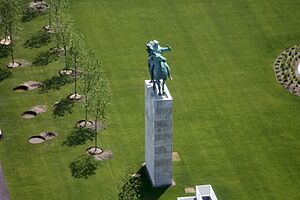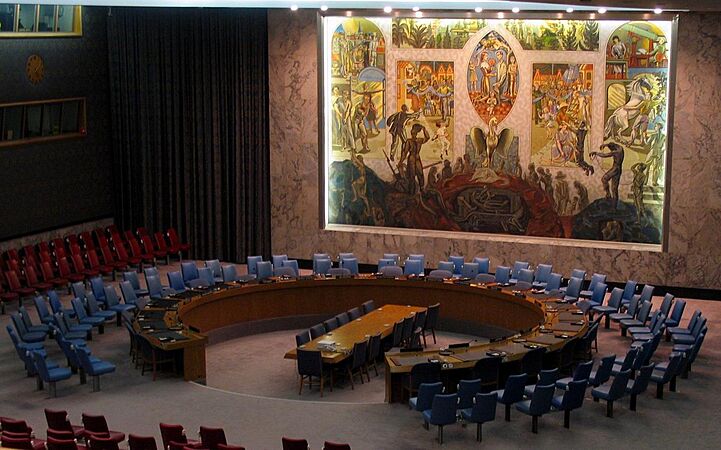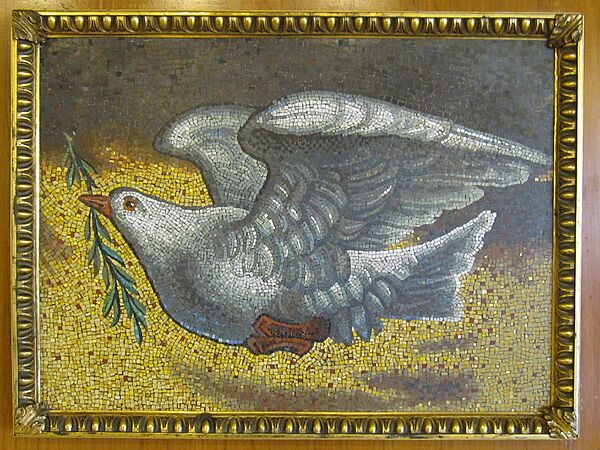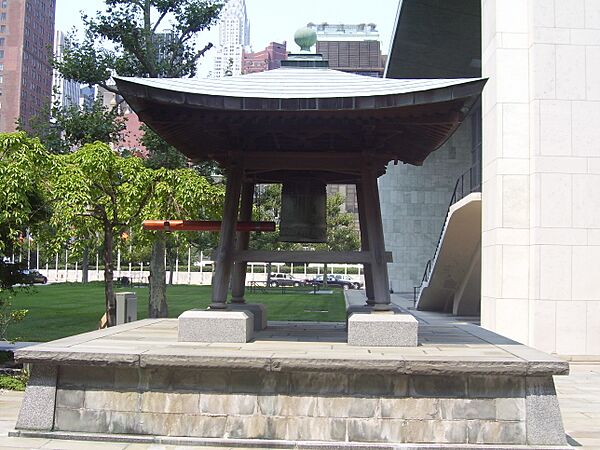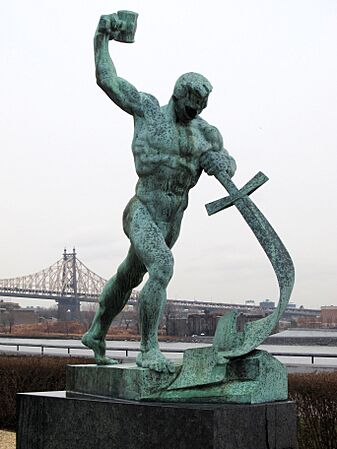United Nations Art Collection facts for kids
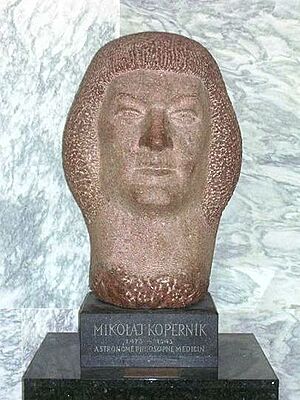
The United Nations Art Collection is a special group of artworks and historical items. These pieces are given as gifts to the United Nations by its member countries, groups, or even individuals. These artistic treasures, like sculptures, paintings, tapestries, and mosaics, show off the "arts of nations." You can find them displayed at the United Nations Headquarters in New York City and other UN locations. This makes the UN like a "small museum" filled with art from all over the world.
Countries follow special rules when they give official gifts to the United Nations. There are ceremonies and speeches when these gifts are shown for the first time. Each country usually gives only one main gift, and they are responsible for setting it up. These gifts show the important ideas and values of the UN as a worldwide organization.
Contents
Art Collection History
Art from the 1950s
In 1952, two large paintings by artist Fernand Léger were put up in the General Assembly Hall.
Also in 1952, a big painting called the United Nations Security Council mural by Per Krohg was installed.
In June 1954, the Japanese Peace Bell was given to the UN by a Japanese group. This bell was made from coins collected by people, including children, from 60 different countries! It sits in a special wooden house that looks like a Japanese shrine. The bell rings twice a year: once on the first day of Spring, and again on September 21st, when the General Assembly starts its meeting.
In 1956, Brazil gave the UN two paintings by artist Candido Portinari called War and Peace. These paintings don't show weapons. Instead, they show the sadness of people affected by war. They highlight how important it is to keep peace and stop violent fights.
In 1959, the Soviet Union gave the UN a bronze statue. It shows the idea of Let Us Beat Swords into Ploughshares. Sculpted by Evgeniy Vuchetich, it represents humanity's wish to end wars. It shows weapons being turned into tools that help people, like farming tools.
Art from the 1960s
In 1964, a sculpture called Single Form was given to the UN. It was made by Barbara Hepworth to remember Dag Hammarskjöld. He was the UN Secretary-General and died in a plane crash in 1961.
Also in 1964, a large stained glass window by Marc Chagall was given to the UN. It is called Peace. UN staff members and Chagall himself donated it to honor Dag Hammarskjöld. This colorful window has many symbols that represent love and peace.
In 1966, a bronze sculpture called Anyanwu was given to the UN by Nigeria. It was made by Nigerian artist Ben Enwonwu. This sculpture represents Ani, an important earth goddess in the Igbo culture of Nigeria. It stands 6 feet tall.
Art from the 1980s
In 1983, the President of Colombia, Belisario Betancur, gave a large painting to the UN. It was an oil painting by Alejandro Obregon called Amanecer en los Andes. You can see this painting on the second floor of the General Assembly Building.
In 1985, Nancy Reagan, the First Lady of the United States, gave a mosaic to the UN. This was to celebrate the organization's 40th anniversary. The Golden Rule mosaic was made by artists from Venice. It was based on a painting by Norman Rockwell. The mosaic shows people of all backgrounds and shares the message: "do unto others as you would have them do unto you".
From 1985 until 2009, a life-size tapestry copy of Pablo Picasso's famous 1937 painting, Guernica, was displayed at the UN. It was near the entrance to the Security Council room.
Art from the 1990s
In 1996, a sculpture called Sphere Within Sphere by Arnaldo Pomodoro was given to the UN. It was a gift from Italy.
-
The Security Council meeting room shows the mural by Per Krohg (1952).
-
Dove of Peace, given by Pope John Paul II during his visit to the United Nations on October 2, 1979.
-
Single Form by Barbara Hepworth is in the pool in front of the Secretariat Building.
Caring for the Art Collection
The UN Arts Committee is mainly in charge of taking care of this collection. Groups like the Maecenas World Patrimony Foundation also help the United Nations. They raise money to preserve these important artworks and international treasures. However, about 50 gifts are currently stored in the basement, and some have been there for many years.
See also
 In Spanish: Colección de arte de las Naciones Unidas para niños
In Spanish: Colección de arte de las Naciones Unidas para niños
- Celestial Sphere Woodrow Wilson Memorial
- United Nations Slavery Memorial


